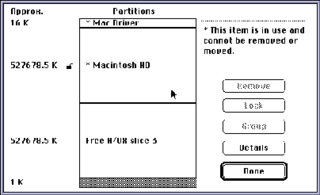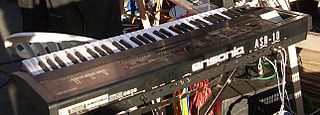Hierarchical File System (HFS) is a proprietary file system developed by Apple Inc. for use in computer systems running Mac OS. Originally designed for use on floppy and hard disks, it can also be found on read-only media such as CD-ROMs. HFS is also referred to as Mac OS Standard, while its successor, HFS Plus, is also called Mac OS Extended.

The Macintosh Plus computer is the third model in the Macintosh line, introduced on January 16, 1986, two years after the original Macintosh and a little more than a year after the Macintosh 512K, with a price tag of US$2599. As an evolutionary improvement over the 512K, it shipped with 1 MB of RAM standard, expandable to 4 MB, and an external SCSI peripheral bus, among smaller improvements. Originally, the computer's case was the same beige color as the original Macintosh, Pantone 453, however in 1987, the case color was changed to the long-lived, warm gray "Platinum" color. It is the earliest Macintosh model able to run System 7.

The Macintosh SE is a personal computer designed, manufactured, and sold by Apple Computer, Inc. from March 1987 to October 1990. It marked a significant improvement on the Macintosh Plus design and was introduced by Apple at the same time as the Macintosh II.
REV is a removable hard disk storage system from Iomega.
HFS Plus or HFS+ is a journaling file system developed by Apple Inc. It replaced the Hierarchical File System (HFS) as the primary file system of Apple computers with the 1998 release of Mac OS 8.1. HFS+ continued as the primary Mac OS X file system until it was itself replaced with the Apple File System (APFS), released with macOS High Sierra in 2017. HFS+ is also one of the formats used by the iPod digital music player.

The ProFile was the first hard disk drive produced by Apple Computer, initially for use with the Apple III personal computer. The original model had a formatted capacity of 5 MB and connected to a special interface card that plugged into an Apple III slot. In 1983, Apple offered a ProFile interface card for the Apple II, with software support for Apple ProDOS and Apple Pascal.

The USB mass storage device class is a set of computing communications protocols, specifically a USB Device Class, defined by the USB Implementers Forum that makes a USB device accessible to a host computing device and enables file transfers between the host and the USB device. To a host, the USB device acts as an external hard drive; the protocol set interfaces with a number of storage devices.

Disk Utility is a system utility for performing disk and disk volume-related tasks on the macOS operating system by Apple Inc.

Apple HD SC Setup is a small software utility that was bundled with various versions of the classic Mac OS and A/UX operating systems made by Apple Computer. Introduced with Apple's first SCSI hard drive, the Hard Disk 20SC in September 1986, Apple HD SC Setup can update drivers and partition and initialize hard disks. It was often used when reinstalling the operating system of an Apple Macintosh computer, or to repair corrupt partition information on a SCSI hard disk. Prior to its introduction, the formatting of disks was handled exclusively by the Mac's Finder application, or by third-party formatting utility software customized for a specific disk drive.

AppleCD is a range of SCSI-based CD-ROM drives for Apple Macintosh personal computers, manufactured and sold by Apple Computer from the late 1980s to late 1990s. Earlier AppleCD drives required a CD caddy in order to be used, while later models used a tray-loading mechanism. The original model introduced in 1988 was simply called the AppleCD SC. There was also a version of the CD drive that did not have the Apple logo.

Time Machine is a backup software application distributed as part of macOS, the desktop operating system developed by Apple. The software is designed to work with external storage devices and most commonly used with external disk drives. It was first introduced in Mac OS X Leopard.

Target Disk Mode is a boot mode unique to Macintosh computers.

The PowerBook 150 is a laptop personal computer created by Apple Computer, Inc. which was introduced on July 13, 1994, and released on July 18, 1994. It was the last member of the PowerBook 100 series to use the original case design, the most affordable of the series when introduced and also the last consumer model.

The Macintosh Hard Disk 20 was the first hard drive developed by Apple Computer specifically for use with the Macintosh 512K. Introduced on September 17, 1985, it was part of Apple's long-awaited solution toward completing the Macintosh Office announced in January 1985. It would be over a year more before Apple would release the file server software AppleShare that would link all of the hardware together. By that time the SCSI interface introduced on the Macintosh Plus in January 1986, would accommodate far faster and more efficient hard drives, rendering the Hard Disk 20 virtually obsolete.

The Ensoniq ASR-10 was a sampling keyboard produced by Ensoniq between 1992 and 1998. The ASR-10 was a follow up product to the very popular Ensoniq EPS and Ensoniq EPS-16+ performance samplers, and was also available with a piano style weighted keyboard (ASR-88) and a rackmount version (ASR-10R). At the time, the machine was one of the most powerful samplers available.

The Apple Hard Disk 20SC is Apple's first SCSI based hard drive for the Apple II family as well as the Macintosh and other third party computers using an industry standard SCSI interface.

The Macintosh External Disk Drive is the original model in a series of external 3 1⁄2-inch floppy disk drives manufactured and sold by Apple Computer exclusively for the Macintosh series of computers introduced in January 1984. Later, Apple would unify their external drives to work cross-platform between the Macintosh and Apple II product lines, dropping the name "Macintosh" from the drives. Though Apple had been producing external floppy disk drives prior to 1984, they were exclusively developed for the Apple II, III and Lisa computers using the industry standard 5 1⁄4-inch flexible disk format. The Macintosh external drives were the first to widely introduce Sony's new 3 1⁄2-inch rigid disk standard commercially and throughout their product line. Apple produced only one external 3 1⁄2-inch drive exclusively for use with the Apple II series called the Apple UniDisk 3.5.

Apple Disk Image is a disk image format commonly used by the macOS operating system. When opened, an Apple Disk Image is mounted as a volume within the Macintosh Finder.
The Advanced Disc Filing System (ADFS) is a computing file system unique to the Acorn computer range and RISC OS-based successors. Initially based on the rare Acorn Winchester Filing System, it was renamed to the Advanced Disc Filing System when support for floppy discs was added and on later 32-bit systems a variant of a PC-style floppy controller.
Apple File System (APFS) is a proprietary file system for macOS High Sierra (10.13) and later, iOS 10.3 and later, tvOS 10.2 and later, watchOS 3.2 and later, and all versions of iPadOS, developed and deployed by Apple Inc. It aims to fix core problems of HFS+, APFS's predecessor on these operating systems. Apple File System is optimized for flash and solid-state drive storage, with a primary focus on encryption.













